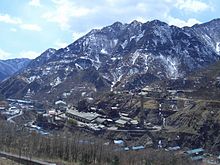Ashio copper mine
The former Ashio copper mine ( Japanese 足 尾 銅山 Ashio dōzan ) in Tochigi Prefecture southwest of Nikkō was privatized at the beginning of the Meiji period . It then became known to be responsible for the first human-made environmental destruction in Japan.
history
In 1610, two farmers discovered copper ore in the Ashio area. Mining soon began , and by 1680 the Ashio copper mine, operated by Bakufu , was generating rich returns. At the beginning of the 19th century, however, hardly any ore was found , and operations ceased in 1817.
After the Meiji restoration , the mining entrepreneur Furukawa Ichibei acquired the state-owned mine in 1877. Furukawa expanded the mine on a large scale by mechanizing the extraction and improving management. Japan's first hydropower plant was built there by Siemens in 1890. By the end of the Meiji period , the mine was already producing 40% of the copper in Japan.
In 1916 the community had reached its peak with 38,428 inhabitants, from then on the number of inhabitants fell due to further mechanization, it leveled off at around 20,000, but then fell to around 10,000 inhabitants from 1960 due to the decreasing productivity of the mine. On February 28, 1973, at the end of the 1972/73 marketing year, the mine was closed.
With the growing production, the mine caused great environmental problems. Its wastewater flowed untreated into the rivers Watarase and Tone and caused fish deaths, regularly flooded the rice-growing areas, which led to health problems for the population. The MP Tanaka Shōzō (1841-1913), supported by Shimada Saburō and many journalists, socialists and Christian humanitarian people, brought in a petition to close the mine in 1891, but it was rejected. The pollution increased further and led to mass protests from 1897, which led to clashes with the law enforcement officers.
The government directed the mine to reduce pollution as agreed in 1897, but the results were unsatisfactory. So in 1901 Tanaka turned directly to the emperor. - Disappointed by the general inaction, Tanaka gave up his seat in the House of Commons that same year. - The government declared the area around Yanaka village to be a flood plain and demolished the village in 1907, despite the protests supported by Tanaka. - Resistance gradually decreased, although the now enacted law on pollution from copper mining proved inadequate. Because of the environmental problems and violent disputes with the workers, the production of the mine decreased in the late Meiji and then in the Taisho period . In 1973 the mine was finally closed. In 1974 the "Environmental Disputes Coordination Commission" (公害 等 調整 調整, Kōgaitō chōsei iinkai) awarded 7 million US dollars in compensation to the farmers who had suffered from the contaminated sewage.
The waters have been fine again since they were closed, but the immediate vicinity of the mine, a deeply cut valley, had lost all vegetation due to the long-term air pollution due to the unprotected smelting. For years, attempts have been made to lavishly green the bare rock and now to market the area as a tourist attraction.
Remarks
- ↑ While Siemens gained a foothold in northeastern Japan, General Electric succeeded in western Japan. To this day, electricity is transmitted at 50 Hz in north-eastern Japan and at 60 Hz in western Japan. Frequency-dependent devices such as turntables were delivered with adjustable gears.
literature
- Ashio-machi Kankyō-kyōkai (Ed.): Ashio-machi gaidobukku, o. J. circa 1990.
- S. Noma (Ed.): Ashio Copper Mine Incident . In: Japan. An Illustrated Encyclopedia. Kodansha, 1993, ISBN 4-06-205938-X .
- Hunter, Janet: Ashio Copper Mine . In: Concise Dictionary of Modern Japanese History. Kodansha International, 1984. ISBN 4-7700-1193-8 .
Web links
Coordinates: 36 ° 39 ′ 11 ″ N , 139 ° 26 ′ 52 ″ E
